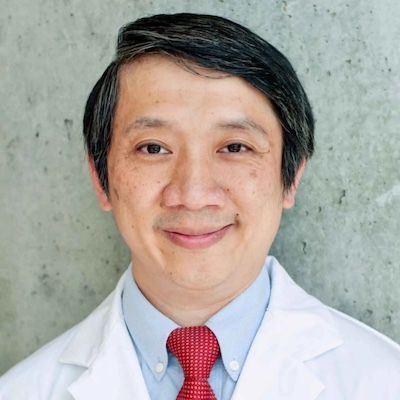Faculty Profile: Innovating in neuroscience and engineering
By Max Martin, MMJC'19
Dr. Victor Yang dreams of building better surgical devices.
Now, the next chapter of his journey to do just that will take place at Schulich Medicine & Dentistry, as the innovative neuroscientist and biomedical engineer joins the faculty in the Department of Clinical Neurological Sciences.
Yang said the collaborative environment found in London, Ontario’s health care network makes it the perfect place to turn his dreams into reality.
“I’m looking forward to the research environment at the University, I think it will be refreshing,” he said. “I hope we will be able to make a lot of technologies mature and make them available to patients. That’s what I hope to do in the next 10 years.”
 Passionate about science from a young age, Yang’s career in medicine stemmed from his undergraduate studies in engineering. In his fourth year, his trajectory took a turn while attempting to build a surgical microscope for a thesis project.
Passionate about science from a young age, Yang’s career in medicine stemmed from his undergraduate studies in engineering. In his fourth year, his trajectory took a turn while attempting to build a surgical microscope for a thesis project.
“I thought I did a great job, but when we were able to try it on patients, it turned out I didn’t do a good job,” Yang recalled. He said his supervisor and mentor helped him realize he wouldn’t be able to build successful microscopes without being a neurosurgeon himself – which led him on the path to becoming a doctor.
Yang obtained his MD from the University of Toronto in 2006. He also holds a PhD in Medical Biophysics after completing a Master of Applied Science in Electrical and Computer Engineering.
He credits the legacy of ground-breaking neuroscience advances at Schulich Medicine & Dentistry and in London – including those of Dr. Charles Drake – as factors in deciding to move his research labs to the Forest City.
“The scientists at Robarts, they’re world class,” he said, calling imaging researchers like Aaron Fenster and Terry Peters “rock stars” in the field.
Yang was able to witness firsthand the power of London’s teamwork a few years ago when he assisted a team of neurosurgeons at University Hospital with a difficult case, helping to show them how to use speciality cardiology equipment for imaging in the brain vasculature.
“I came by and found the whole team was very collaborative,” he said. “We were very happy with what we did that day.”
Building on his expertise in imaging and neuroscience, Yang’s research lab at Schulich Medicine & Dentistry will focus on three main areas.
First, he’s exploring the use of catheter-based technology to treat neurovascular diseases and spinal cord injury. That combines with his interests in imaging and using light-based therapeutics.
Robotics and image-guided therapies are another major priority.
“Surgeons are like artists, but the issue with artistry is it’s very hard to standardize,” Yang explained. “We’re hoping to digitize surgery, not only in imaging but in delivery of surgery as well. If we can digitize it, we can standardize it.”
He points to University Hospital and the School’s “long tradition” in robotics as a boon for his future research.
“We are going to be very collaborative with patients and physicians in the entire London health care network,” he said. “Hopefully we can make some real impacts for patients.”
The third focus of the Yang lab will be on developing material-based therapeutics and treatments. He’s already involved in a major multi-institution project called Mend the Gap.
The University of British Columbia-led Mend the Gap team recently received $24 million from Canada’s New Frontiers in Research Fund 2020 Transformation stream to investigate using biomaterials to heal spinal cord injuries.
A key challenge in treating spinal cord injuries — the kind caused by impact from a car crash, a fall or a sporting activity — is repairing the gap that is formed when the spine is broken.
The team is exploring using a soft gel that contains tiny magnetic rods that are aligned using an external magnet, creating guide rails that support the nerve fibres to grow in the right direction, eventually crossing the gap.
Yang will lead the efforts to develop image-guided surgical technologies to support biomaterial delivery.
“To do this, we will build on the foundations of image-guided surgery using multiple types of imaging to initially guide robotic injections, and eventually, to create new methods for gel delivery,” he explained. “We envision a path from rigid mechanical robotics towards minimally invasive soft surgical robots.”
Yang’s past innovations and biomedical developments have been recognized on the international stage.
In 2018, Yang’s team was honoured with the Congress of Neurological Surgeons Innovator of the Year Award. That same year, the team also received the Refined Manufacturing Acceleration Process (ReMAP) Commercialization Prize. A year prior his team received the Frost & Sullivan New Product Innovation Award.
“Dr. Yang is a world class neurosurgeon who brings expertise in image guided neurosurgical and neurovascular therapeutics,” said Dr. David Steven, Chair/Chief, Clinical Neurological Sciences. “Applying his clinical expertise to his biomedical engineering background allows Dr. Yang to find novel solutions to challenges neurosurgeons face in the operating room. This will have an immediate and profound impact on the research profile of our Department and the University.”
Yang credits teamwork and collaboration as cornerstones of his past success and hopes to foster the next generation of leading doctors, engineers and scientists at Schulich Medicine & Dentistry.
“As a mentor, my job is to get you to your fullest potential,” he said. “No one can do this alone. We hope to form an army of learners and hope they all enjoy the journey.”








